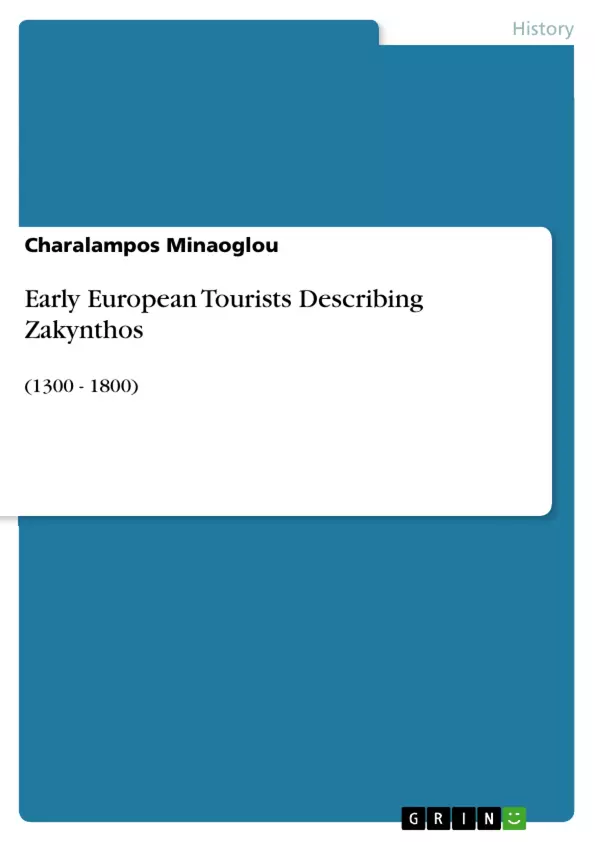Blick ins Buch

Early European Tourists Describing Zakynthos
(1300 - 1800)
Fachbuch, 2013
72 Seiten, Note: A
Leseprobe
Inhaltsverzeichnis (Table of Contents)
- PREFACE
- INTRODUCTION
- Lionardo Frescobaldi
- Simone Sigoli
- Jacob Marcellus
- Jerome Maurand
- Philippe Fresne Canaye
- Jean Palerne
- Giovanni Zuallardo
- Thomas Dallam
- William Biddulph
- William Lithgow
- Sandys
- Sieur de Loir
- Sebastiani
- Grelot
- Bernard Randolph
- Jacob Spon
- De Mirone
- Alexander Drummond
Zielsetzung und Themenschwerpunkte (Objectives and Key Themes)
This work aims to provide a comprehensive overview of early European travelers' accounts of the Greek island of Zakynthos, spanning from the 14th to the 18th centuries. The author delves into the historical context of these accounts, analyzing the motivations, perspectives, and experiences of these tourists. Key themes explored in the text include:- The changing perceptions of Zakynthos and its people over time.
- The impact of travel and tourism on the island's social, economic, and cultural landscape.
- The role of early European travelers in shaping the image of Zakynthos in the West.
- The evolving relationship between Greece and Europe through the lens of travel narratives.
- The significance of Zakynthos as a historical and cultural crossroads in the Mediterranean.
Zusammenfassung der Kapitel (Chapter Summaries)
The text explores the accounts of various European travelers who visited Zakynthos between the 14th and 18th centuries. Each chapter focuses on a specific traveler, analyzing their observations and interpretations of the island. The author provides context for each account, highlighting the historical background and motivations of the travelers. This analysis provides a nuanced understanding of how early European perceptions of Zakynthos were shaped by a combination of personal experiences, cultural biases, and contemporary geopolitical factors.Schlüsselwörter (Keywords)
This work focuses on early European tourism, travel narratives, Zakynthos, Greece, historical geography, cultural exchange, perceptions of the "Other," Mediterranean history, and the evolution of tourism in the region. The text examines the motivations and experiences of travelers from diverse backgrounds, providing insights into the complex interplay of history, culture, and tourism in shaping our understanding of the past.
Ende der Leseprobe aus 72 Seiten
- nach oben
Details
- Titel
- Early European Tourists Describing Zakynthos
- Untertitel
- (1300 - 1800)
- Veranstaltung
- Early Modern Greek History
- Note
- A
- Autor
- Dr. Charalampos Minaoglou (Autor:in)
- Erscheinungsjahr
- 2013
- Seiten
- 72
- Katalognummer
- V231256
- ISBN (eBook)
- 9783656505679
- ISBN (Buch)
- 9783656505846
- Dateigröße
- 634 KB
- Sprache
- Englisch
- Schlagworte
- early european tourists describing zakynthos
- Produktsicherheit
- GRIN Publishing GmbH
- Preis (Ebook)
- US$ 17,99
- Preis (Book)
- US$ 26,99
- Arbeit zitieren
- Dr. Charalampos Minaoglou (Autor:in), 2013, Early European Tourists Describing Zakynthos, München, Page::Imprint:: GRINVerlagOHG, https://www.diplomarbeiten24.de/document/231256
Allgemein
Autoren
- Autor werden
- Ihre Optionen
- Vertriebskanäle
- Premium Services
- Autorenprofil
- Textarten und Formate
- Services für Verlage, Hochschulen, Unternehmen
Premium Services
FAQ
Marketing
Dissertationen
Leser & Käufer
Zahlungsmethoden

Copyright
- © GRIN Publishing GmbH.
- Alle Inhalte urheberrechtlich geschützt. Kopieren und verbreiten untersagt.
- info@grin.com
- AGB
- Open Publishing
Über GRIN
Der GRIN Verlag hat sich seit 1998 auf die Veröffentlichung akademischer eBooks und Bücher spezialisiert. Der GRIN Verlag steht damit als erstes Unternehmen für User Generated Quality Content. Die Verlagsseiten GRIN.com, Hausarbeiten.de und Diplomarbeiten24 bieten für Hochschullehrer, Absolventen und Studenten die ideale Plattform, wissenschaftliche Texte wie Hausarbeiten, Referate, Bachelorarbeiten, Masterarbeiten, Diplomarbeiten, Dissertationen und wissenschaftliche Aufsätze einem breiten Publikum zu präsentieren.
Kostenfreie Veröffentlichung: Hausarbeit, Bachelorarbeit, Diplomarbeit, Dissertation, Masterarbeit, Interpretation oder Referat jetzt veröffentlichen!
- GRIN Verlag GmbH
-
- Nymphenburger Str. 86
- 80636
- Munich, Deutschland
- +49 89-550559-0
- +49 89-550559-10
- info@grin.com
-









